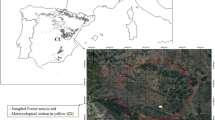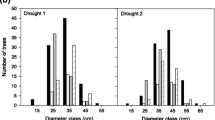Abstract
Masting is the synchronous and highly variable production of fruit within a population. Although several hypotheses have been proposed to explain why and how masting evolved in plants as a reproductive strategy, the factors that trigger a large reproductive effort in a particular year are still not well understood. While both weather and resources have been proposed to play an important role, testing these hypotheses has been challenging due to a lack of long-term data and appropriate experimental designs. In this manuscript, we used 18 years of acorn production data to analyze the relationship between resources, weather, and masting in black oak (Quercus velutina) and chestnut oak (Q. montana). The data were collected in southeast Ohio as part of the Fire and Fire Surrogate (FFS) study, which applied silvicultural treatments (i.e., thinning and prescribed fires) to reduce competition and manipulate resources. We found species-specific responses to the thinning and fire treatments, with an overall increase in acorn production for chestnut oak in the thin + burn treatment and an increase for black oak in the thin-only treatment compared to the control. Chestnut oak reproduction also had strong positive relationships with warm spring temperatures, and a positive change in summer temperatures compared to the previous year (i.e., summer temperatures that went from cool to warm). For black oak, warm spring temperatures increased acorn production while later starts to spring warming the year before decreased acorn production. These results support the hypotheses that both resources and weather (as a cue and as a limiting factor) are important for masting in oaks. Thus, both factors should be included in predictive models for acorn production under current and future climate conditions.




Similar content being viewed by others
Data availability
All data and the associated R script are archived in the Environmental Data Initiative (DOI: https://doi.org/10.6073/pasta/2ee69498e7bbd2784267b9f8c6bfa668).
Code availability
The R script used for data analysis is also archived in the Environmental Data Initiative (see DOI link above).
References
Albrecht MA, McCarthy BC (2006) Effects of prescribed fire and thinning on tree recruitment patterns in central hardwood forests. For Ecol Manage 226:88–103
Anning AK, McCarthy BC (2013) Competition, size and age affect tree growth response to fuel reduction treatments in mixed-oak forests of Ohio. For Ecol Manage 307:74–83
Anning AK, McCarthy BC (2013) Long-term effects of prescribed fire and thinning on residual tree growth in mixed-oak forests of Southern Ohio. Ecosystems 16:1473–1486
Barton K (2020) MuMIn: multi-model inference. Version 1.43.17.
Boerner REJ, Brinkman JA, Sutherland EK (2004) Effects of fire at two frequencies on nitrogen transformations and soil chemistry in a nitrogen-enriched forest landscape. Can J For Res 34:609–618
Boerner REJ, Coates AT, Yaussy DA, Waldrop TA (2008) Assessing ecosystem restoration alternatives in eastern deciduous forests: the view from belowground. Restoration Ecol 16:425–434
Bogdziewicz M, Crone EE, Steele MA, Zwolak R (2017) Effects of nitrogen deposition on reproduction in a masting tree: benefits of higher seed production are trumped by negative biotic interactions. J Ecol 105:310–320
Caignard T, Kremer A, Firmat C, Nicolas M, Venner S, Delzon S (2017) Increasing spring temperatures favor oak seed production in temperate areas. Sci Rep 7:8
Cecich RA (1997) Influence of weather on pollination and acorn production in two species of Missouri oaks. General Technical Report—North Central Forest Experiment Station, USDA Forest Service: 252–261
Cecich RA, Haenchen WW (1995) Pollination biology of northern red and black oak. General Technical Report—Northeastern Forest Experiment Station, USDA Forest Service: 238-246
Cecich RA, Sullivan NH (1999) Influence of weather at time of pollination on acorn production of Quercus alba and Quercus velutina. Can J For Res 29:1817–1823
Espelta JM, Cortés P, Molowny-Horas R, Sánchez-Humanes B, Retana J (2008) Masting mediated by summer drought reduces acorn predation in mediterranean oak forests. Ecology 89:805–817
Fralish JS (2004) The keystone role of oak and hickory in the central hardwood forest. vol Gen Tech R.
Healy WM (1997) Thinning New England oak stands to enhance acorn production. Northern J Appl For 14:152–156
Healy WM, Lewis AM, Boose EF (1999) Variation of red oak acorn production. For Ecol Manage 116:1–11
Iverson LR, Hutchinson TF, Prasad AM, Peters MP (2008) Thinning, fire, and oak regeneration across a heterogeneous landscape in the eastern US: 7-year results. For Ecol Manage 255:3035–3050
Janzen DH (1971) Seed predation by animals. Annu Rev Ecol Syst 2:465–492
Kasprzyk I, Ortyl B, Dulska-Jez A (2014) Relationships among weather parameters, airborne pollen and seed crops of Fagus and Quercus in Poland. Agric For Meteorol 197:111–122
Kelly D et al (2013) Of mast and mean: differential-temperature cue makes mast seeding insensitive to climate change. Ecol Lett 16:90–98
Kelly D, Sork VL (2002) Mast seeding in perennial plants: Why, how, where? Annu Rev Ecol Syst 33:427–447
Koenig WD et al (2016) Is the relationship between mast-seeding and weather in oaks related to their life-history or phylogeny? Ecology 97:2603–2615
Koenig WD, Knops JMH (2005) The mystery of masting in trees. Am Sci 93:340–347
Koenig WD, Knops JMH (2014) Environmental correlates of acorn production by four species of Minnesota oaks. Popul Ecol 56:63–71
Koenig WD, Knops JMH, Carmen WJ, Pearse IS (2015) What drives masting? The phenological synchrony hypothesis. Ecology 96:184–192
Koenig WD, Knops JMH, Carmen WJ, Stanback MT, Mumme RL (2008) Acorn production by oaks in central coastal California: influence of weather at three levels. Can J For Res 26:1677–1683
Lombardo JA, McCarthy BC (2008) Silvicultural treatment effects on oak seed production and predation by acorn weevils in southeastern Ohio. For Ecol Manage 255:2566–2576
McCarthy BC, Quinn JA (1989) Within- and among-tree variation in flower and fruit production in two species of Carya (Juglandacea). Am J Bot 76:1015–1023
McShea WJ, Healy WM, Devers P, Fearer T, Koch FH, Stauffer D, Waldon J (2007) Forestry matters: decline of oaks will impact wildlife in hardwood forests. J Wildl Manage 71:1717–1728
Merkle SA, Feret PP, Croxdale JG, Sharik TL (1980) Development of floral primordia in white oak. For Sci 26:238–250
Norton DA, Kelly D (1988) Mast seeding over 33 years by Dacrydium cupressinum Lamb. (rimu) (Podocarpaceae) in New Zealand: the importance of economies of scale. Funct Ecol 2:399–408
Ostfeld RS, Keesing F (2000) Pulsed resouces and community dynamics of consumers in terrestrial ecosystems. Trends Ecol Evol 15:232–237
Pearse IS, Koenig WD, Kelly D (2016) Mechanisms of mast seeding: resources, weather, cues, and selection. New Phytol 212:546–562
Pearse IS, Koenig WD, Knops JMH (2014) Cues versus proximate drivers: testing the mechanism behind masting behavior. Oikos 123:179–184
Pearse IS, LaMontagne JM, Koenig WD (2017) Inter-annual variation in seed production has increased over time (1900–2014). Proc R Soc Lond Ser B-Biol Sci 284:7
Pérez-Ramos IM, Aponte C, García LV, Padilla-Díaz CM, Marañón T (2014) Why is seed production so variable among individuals? A ten-year study with oaks reveals the importance of soil environment. PLoS ONE 9:1–18
Pinheiro J, Bates D, DebRoy S, Sarkar D, R_Core_Team (2020) _nlme: Linear and Nonlinear Mixed Effects Models_. R package version 3.1-147
R_Core_Team (2020) R: A language and environment for statistical computing. R Foundation for Statistical Computing, Vienna
Samarth Kelly D, Turnbull MH, Jameson PE (2020) Molecular control of masting: an introduction to an epigenetic summer memory. Ann Bot 125:851–858
Satake A, Iwasa Y (2002) The synchronized and intermittent reproduction of forest trees is mediated by the Moran effect, only in association with pollen coupling. J Ecol 90:830–838
Sharp WM, Chisman HH (1961) Flowering and fruiting in the white oaks. I. Staminate flowering through pollen dispersal. Ecology 42:365–372
Sharp WM, Sprague VG (1967) Flowering and fruiting in white oaks. Pistillate flowering, acorn development, weather, and yields. Ecology 48:243–251
Silvertown JW (1980) The evolutionary ecology of mast seeding in trees. Biol J Linnean Soc 14:235–250
Smaill SJ, Clinton PW, Allen RB, Davis MR (2011) Climate cues and resources interact to determine seed production by a masting species. J Ecol 99:870–877
Sork V, Bramble J (1993) Prediction of acorn crops in three species of North American oaks: Quercus alba, Q rubra and Q velutina. Ann Sci For 50:128s–136s
Sork VL (1993) Evolutionary ecology of mast-seeding in temperate and tropical oaks (Quercus spp.). Vegetatio 107–108:133–147
Sork VL, Bramble J, Sexton O (1993) Ecology of mast-fruiting in 3 species of North American deciduous oaks. Ecology 74:528–541
Willson MF (1983) Plant Reproductive Ecology. John Wiley & Sons, New York
Yasumura Y, Hikosaka K, Hirose T (2006) Resource allocation to vegetative and reproductive growth in relation to mast seeding in Fagus crenata. For Ecol Manage 229:228–233
Yaussy DA, Iverson LR, Matthews SN (2013) Competition and climate affects US hardwood-forest tree mortality. For Sci 59:416–430
Żywiec M, Zielonka T (2013) Does a heavy fruit crop reduce the tree ring increment? Results from a 12-year study in a subalpine zone. Trees 27:1365–1373
Acknowledgements
We thank Bill Borovika and the staff at Vinton Furnace State Experimental Forest for all of their field and data assistance; Rebecca Wagenknecht for field and data collection/analysis; Abby Goszka, Kelsey Bryant, Austin Waag, Jack Monstead, Delaney Gibbs, and Sam Lockhart for assistance in field collections. The original funding for the FFS study was provided by the USDA Forest Service.
Funding
The USDA Forest Service provided the original funding for the Fire and Fire Surrogate (FFS) study.
Author information
Authors and Affiliations
Corresponding author
Ethics declarations
Conflict of interest
The authors declare that they have no conflict of interest.
Additional information
Communicated by William E. Rogers.
Publisher's Note
Springer Nature remains neutral with regard to jurisdictional claims in published maps and institutional affiliations.
Supplementary Information
Below is the link to the electronic supplementary material.
Rights and permissions
About this article
Cite this article
Smith, S.J., McCarthy, B.C., Hutchinson, T.F. et al. Both weather and resources influence masting in chestnut oak (Quercus montana Willd.) and black oak (Q. velutina Lam.). Plant Ecol 222, 409–420 (2021). https://doi.org/10.1007/s11258-021-01115-7
Received:
Accepted:
Published:
Issue Date:
DOI: https://doi.org/10.1007/s11258-021-01115-7




